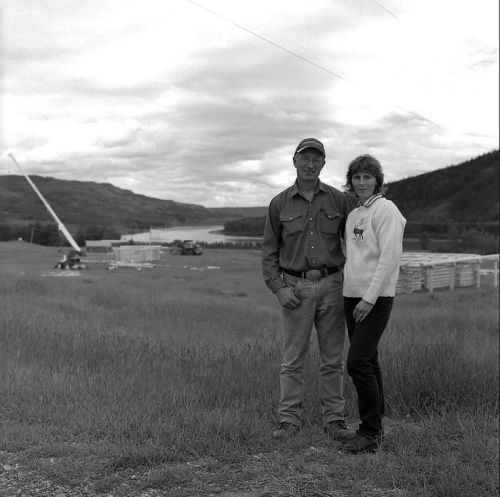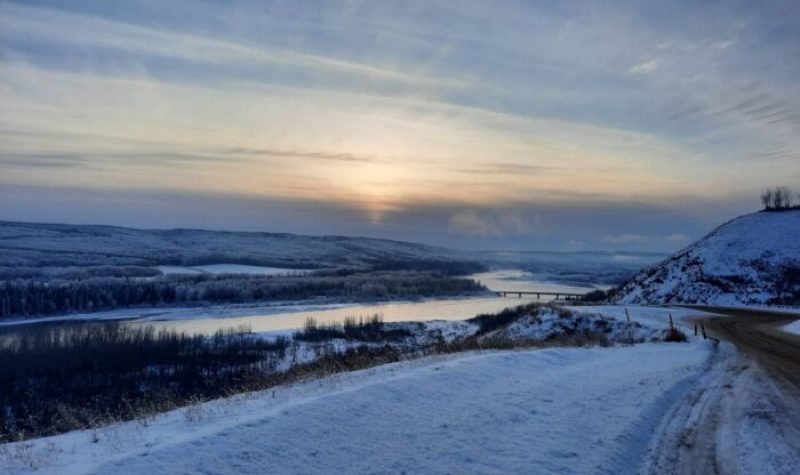Farmer and president of the Peace Valley Landowners’ Association (PVLA) Ken Boon has been at odds with BC Hydro for over a decade. Ever since the Site C megadam project was announced in 2010, Ken Boon and his wife Arlene have been active in opposing the project. The Boons’ multi-generational family farm has been in their possession since the 1940s. The homestead to the farm, built over a hundred years ago, has already been appropriated by BC Hydro though the Boon’s are still living in it for the time being. The river bottom land of the valley, which is to be disturbed by construction of the megadam, is the only class one farmland in BC north of Quesnel. This is mostly due to the east-west orientation of the valley, merged with long days providing lots of light in the summers, as well as being home to soils with very rich natural quality.
Boon says that this unique combination of environmental factors means the valley is able to grow some surprising produce, like cantaloupe and watermelon. “The potential to grow amazing amounts of food here [could] really be utilized. Essentially, you can grow things down here in the valley on this narrow strip that you cannot grow elsewhere in the Peace River Country, which is a huge agriculture area but the very best of it is in the river valley and a lot of it or most of it will be lost to the reservoir or to the realignment of the highway.”

Ken and Arlene Boon run the farm that has been in the family since 1940. Photo courtesy of Ken Boon.
Boon advocates for green-powered, sustainable energy sources, and does not deem Site C to fall within that category. A self-described fiscal conservative, Boon says that the economics of the Site C dam don’t make sense to him. “It's crazy the amount of money being spent on this project for so many crazy things that have nothing to do with generating electricity,” says Boon. “Large hydro is not the way to go anymore.” The initially proposed publicly funded $6.6B project has now soared to an estimated $16B to reach completion. A slew of geotechnical and other design problems are mostly to blame for this cost increase. The foundation for the Site C dam is predominantly on shale, which is used to extract gas through fracking at nearby oil and gas worksites. Induced seismicity caused by fracking has resulted in thousands of earthquakes near the dam. These factors as well as the overall lack of market demand for the amount of electricity Site C would produce reinforces Boon’s view of the dam as costly and unnecessary.
As an alternative, the Boons’ farm utilizes net metering solar power as a source of energy. He believes that the expansion of the electricity grid should be small and localized, and be the primary source of jobs for people working in the energy sector. He believes micro-grids provide electricity benefits to farmers, individuals, and First Nations groups alike. Despite BC Hydro and the federal government seemingly moving in the opposite direction for electricity grids. Citing the massive grid failure in Texas this winter as a lesson to be learned, Boon believes that a smaller scale grid would improve resiliency as catastrophic events will not impact a large range of users.
This idyllic picture Boon paints of their farm and their hopes for the future of sustainable energy is fading away in real time. When asked to describe what day-to-day life currently looks like on the farm, Boon replied by saying “It’s getting kind of grim here”. The house in which he was sitting while doing the interview had been marked for destruction, and it is only a matter of time until that comes to fruition. Just 200 to 400 yards ahead of where Boon was sitting, a bridge was being constructed as BC Hydro was preparing to put a highway “where no one would ever put a highway normally in their right mind” due to the looming flooding of the river.
Life today at the farm looks like logging, topsoil being stripped, and concrete being poured seven days a week, as well as the constant drone of noise and mechanical beeping that comes with it. Ken reminisced about the gorgeous scenic drive that Highway 29 between Fort St. John and Hudson’s Hope used to provide travelers, which is now becoming all but a distant memory.
As Boon said, “Every aspect of what they are doing in this valley is just destructive”.
Listen to a clip of the interview with Ken Boon on CFUR-FM:
Listen to the full audio here:


